This step by step diy project is about 16×40 pavilion with lean to roof plans. This pavilion has a ground area of 16 ft x 40 ft, outside post to outside post, but the roof is wider so it will protect more space. This pavilion features a post frame structure made from 6x6s and 6x8s. The roof has a lean to slope of 4:12. Make sure you read the local building codes before starting the project, so you get aware of the legal requirements and make the necessarily adjustments. Take a look over the rest of my woodworking plans, if you want to get more building inspiration. Premium Plans for this project available in the SHOP.
When buying the lumber, you should select the planks with great care, making sure they are straight and without any visible flaws (cracks, knots, twists, decay). Investing in cedar or other weather resistant lumber is a good idea, as it will pay off on the long run. Use a spirit level to plumb and align the components, before inserting the galvanized screws, otherwise the project won’t have a symmetrical look. If you have all the materials and tools required for the project, you could get the job done in about a day.
Projects made from these plans
16×40 Pavilion with Lean to Roof Plans

Building-a-16×40-lean-to-pavilion
Cut & Shopping Lists
- A – 10 pieces of 6×6 lumber – 8′ long POSTS
- B – 2 pieces of 6×8 lumber – 121 3/8″ long, 2 pieces – 145 3/8″ long, 4 pieces – 118 5/8″ long SUPPORT BEAMS
- C – 5 pieces of 6×8 lumber – 192″ long SUPPORT BEAMS
- D – 26 piece of 6×6 lumber – 36″ long BRACES
- E – 5 piece of 6×6 lumber – 52 3/4″ long, 5 pieces – 23 5/8″ long RIDGE BEAM SUPPORTS
- E – 4 piece of 6×6 lumber – 145 3/8″ long, 4 pieces – 118 5/8″ long RIDGE BEAMS
- F – 8 piece of 6×6 lumber – 48″ long BRACES
- F – 10 piece of 6×6 lumber – 33 1/4″ long BRACES
Tools
![]() Hammer, Tape measure, Framing square, Level
Hammer, Tape measure, Framing square, Level
![]() Miter saw, Drill machinery, Screwdriver, Sander
Miter saw, Drill machinery, Screwdriver, Sander
![]() Concrete mixer, Post hole digger
Concrete mixer, Post hole digger
Time
Related
- PART 1: 16×40 Lean to Pavilion Plans
- PART 2: 16×40 Lean to Roof Plans
16×40 Lean to Pavilion Plans
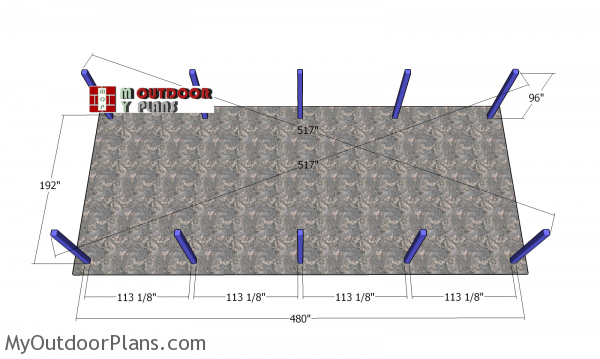
Laying-out-the-posts
First, layout the posts for the 16×40 pavilion. Use batter boards and string to determine the location of the posts. Apply the 3-4-5 rule to every corner of the pavilion, so you make sure they are right angled. Make sure the diagonals are equal. Determining the location for the pavilion is essential, as you have to comply with the local building codes. Make sure the surface is level and remove the vegetation layer.
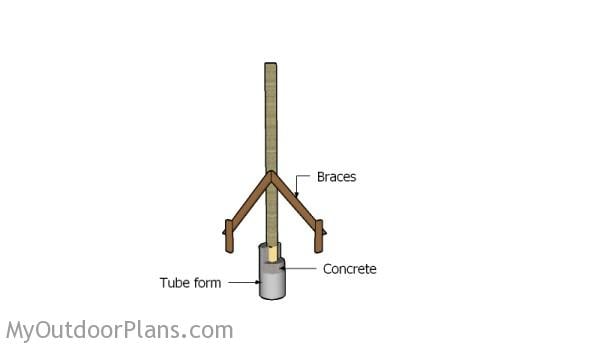
Setting the posts in concrete
You need to set the posts in concrete (about 3-6′ deep – make sure you read the local building codes for accurate information) or use anchors. Use a post hole digger to make the holes. Pour a 2″ layer of concrete on the bottom of the holes so you level them. Fit the tube forms and then the 6×6 posts / fit the anchors. Use a spirit level to make sure the posts are plumb and then secure them temporarily into place with braces. Fill the tubes with concrete and let it dry out as shown on the bags. Make sure the top of the posts are level (use a laser level and a circular saw to make the cuts).
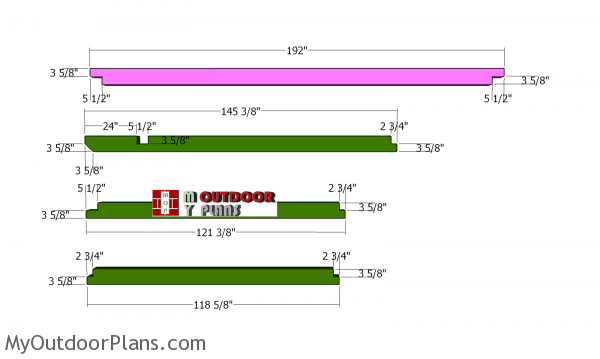
Top-plates
Use 6×8 lumber for the top rails. Mark the cut lines on the beams and then make the cut outs with a circular saw and a chisel. Set the circular saw at 3 5/8″ and then make parallel cuts inside the marked areas. Clean the recess with a chisel and sandpaper.

Fitting-the-side-plates
Fit the top rails to the sides of the pavilion. Notice the 24″ overhangs to the front and back of the pavilion. Drill pilot holes through the plates and insert 8″ screws to lock them to the posts. Use 2 screws for each joint. Make sure the corners are square and plumb the posts vertically

Fitting-the-cross-beams
Fit the cross plates to the pavilion. Align the edges flush and drill pilot holes. Insert the 10″ screws to lock the cross plates into place tightly. Use 2 screws for each joint. Make sure all the corners are square. Use a spirit level to check if the beams are horizontal.
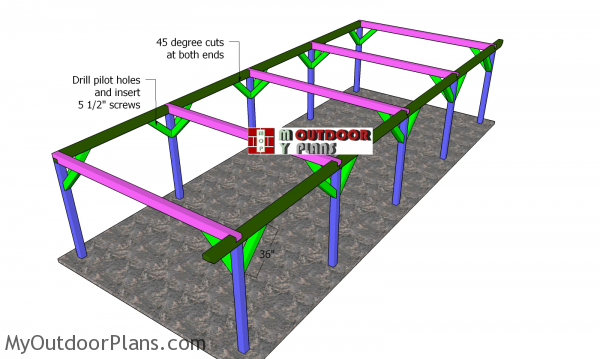
Fitting-the-braces
Build the braces for the front and back of the pavilion from 6×6 lumber. Use a miter saw to make 45 degree cuts to both ends of the braces. Fit the braces to the posts, after you plumb them vertically. Drill pilot holes and insert 5 1/2″ screws to secure the braces into place tightly.
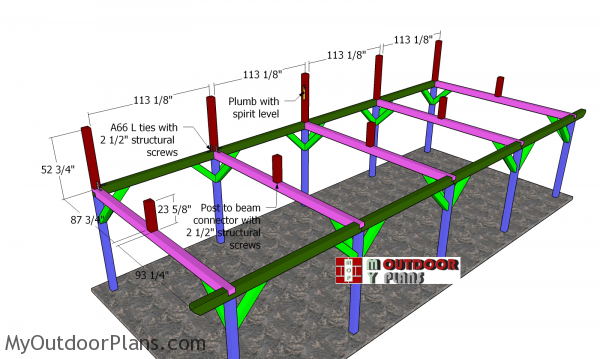
Fitting-the-supports
Center the 6×6 supports to the top of pavilion. Plumb the supports with a spirit level. Use 2 L brackets to secure the posts to the frame pavilion. Use 2 1/2″ structural screws to lock the connectors into place. Use 2 T strong ties to secure the middle post to the top beams. Use post to beam connectors to secure the other supports to the top beams.
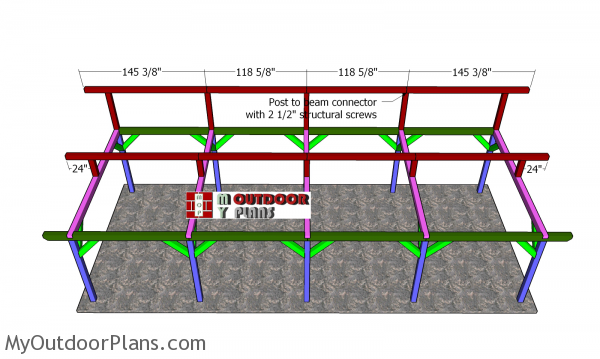
Fitting-the-ridge-beams
Fit the 6×6 beams to the top of the supports. Align the edges flush and make sure the corners are square. Fit the ridge beam to the supports with post to beam connectors. Make sure the corners are square.

Top-ridge-beams
Use 6×6 lumber for the braces. Make 45 degree cuts at both ends of the braces and lock them into place with 5 1/2″ screws, after drilling pilot holes. Align the edges flush and make sure the corners are square before inserting the screws.
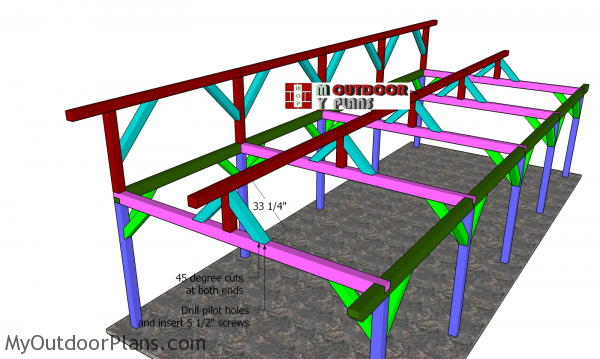
Braces-to-middle-ridge-beam
Use 6×6 lumber for the braces. Make 45 degree cuts at both ends of the braces and lock them into place with 5 1/2″ screws, after drilling pilot holes. Plumb the supports with a spirit level before fitting the braces.
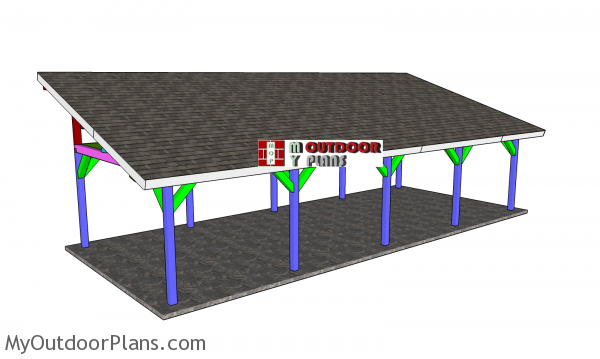
16×40-Lean-to-Pavilion-Plans—assembled
I recommend you to take a look over PART 2 of the project, where I show you how to build the lean to roof for the outdoor pavilion.
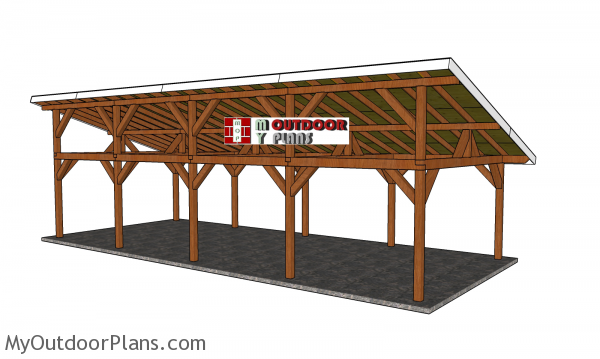
16×40-Lean-to-Pavilion-Plans—back-view
This pavilion makes for a perfect shelter, if you need a large space in your garden to host parties or an entertainment center.

How-to-build-a-16×40-lean-to-pavilion
This is super large backyard pavilion with a lean to roof. The roof structure is strong enough for winds and snow, but I recommend you to read the local codes and make modifications, if necessary. You should also take a look over my 16×40 pavilion with lean to roof, as it makes for a more stylish alternative to this plan. Premium Plans for this project available in the SHOP.
If you want to get PREMIUM PLANS for this project, in a PDF format, please press GET PDF PLANS button bellow. Thank you for the support.
This woodworking project was about 16×40 pavilion with lean to plans. If you want to see more outdoor plans, check out the rest of our step by step projects and follow the instructions to obtain a professional result.


